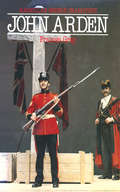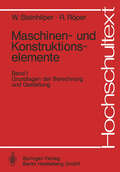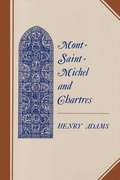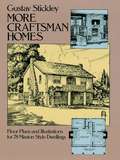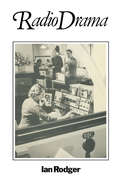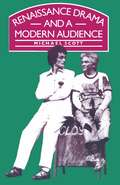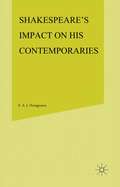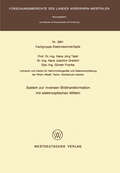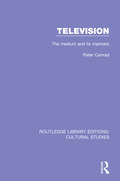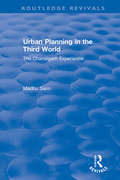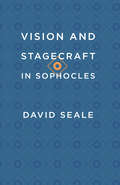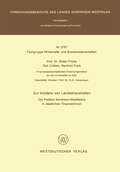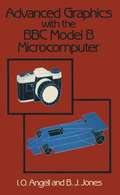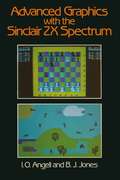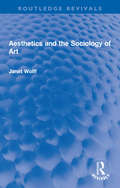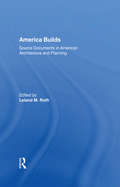- Table View
- List View
Karlsruher Theatergeschichte: Vom Hoftheater zum Staatstheater
by Günther Haass Wilhelm Kappler Bernhard Müller Marie Salaba Hansmartin SchwarzmaierMaschinen- und Konstruktionselemente: Band 1: Grundlagen der Berechnung und Gestaltung (Hochschultext)
by Waldemar Steinhilper Rudolf RöperUnter Technik verstehen wir jene Vorrichtungen und Maßnahmen, mit denen der Mensch die Naturkräfte auf Grund der Kenntnis ihrer Gesetzmäßigkeiten in seinen Dienst stellt, um menschliches Leben und in der Folge Zivilisation und Kultur zu ermögli chen und zu sichern. Das Tätigkeitsfeld der Technik umfaßt global die Erzeugung und Umformung von Energie, Stoff und Information sowie die Orts- und Lagewandlung. Sol che Vorgänge erfolgen durch den Einsatz technischer Systeme (Maschinen, Apparate und Geräte), in denen physikalische und chemische Abläufe unter der Beachtung be sonderer technischer Begriffe wie Funktion, Funktionssicherheit, Herstellbarkeit und Aufwand-Nutzen-Re 1 ati on nutzbar gemacht werden. Mit der Ingeni eurtäti gkeit ver bindet sich daher primär die schöpferische Gestaltung technischer Systeme und sie wird maßgebend gekennzeichnet durch das Konstruieren, d. h. das Auffinden von Ziel vorgaben und deren Verwirklichung durch logische, physikalische und konstruktive Wirkzusammenhänge. Hochtechnisierte Länder, insbesondere die mit nur geringen natürlichen Reichtümern an Bodenschätzen und Energie, sind darauf angewiesen, technische Produkte und Ver fahren höchster Qualität zu schaffen und unterliegen damit einem besonderen Zwang zu außerordentlichen Ingenieurleistungen. Ferner ist die Entwicklung der Technik gekennzeichnet durch immer kürzere Innovationszeiten für technische Produkte, einen wachsenden Grad an Komplexität der Strukturen und eine immer engere Verknüpfung technischer, ökonomischer, sozialer und ökologischer Systeme. Dies bewirkt eine zu nehmend schnellere Veralterung von - z. B. im Studium erworbenen - Kenntnissen und den frühen Verlust von zeitlich begrenzten Vorteilen einer Spezialisierung.
Modern Art And Modernism: A Critical Anthology
by Francis FrascinaModern Art and Modernism offers firsthand material for the study of issues central to the development of modern art, its theory, and criticism. The history of modern art is not simply a history of works of art, it is also a history of ideas interpretations. The works of critics and theorists have not merely been influential in deciding how modern art is to be seen and understood, they have also influenced the course it has taken. The nature of modern art cannot be understood without some analysis of the concept of Modernism itself.Modern Art and Modernism presents a selection of texts by the major contributors to debate on this subject, from Baudelaire and Zola in the nineteenth century to Greenberg and T. J. Clark in our own times. It offers a balanced section of essays by contributors to the mainstream of Modernist criticism, representative examples of writing on the themes of abstraction and expression in modern art, and a number of important contributions to the discussion of aesthetics and the social role of the artist. Several of these are made available in English translation for the first time, and others are brought together from a wide range of periodicals and specialized collections.This book will provide an invaluable resource for teachers and students of modern art, art history, and aesthetics, as well as for general readers interested in the place of modern art in culture and history.
Mont-Saint-Michel and Chartres: A Study of Thirteenth-Century Unity
by Henry AdamsThis first paperback facsimile of the classic 1913 edition includes thirteen photographs and numerous illustrations of the great cathedrals of Northern France. Henry Adams referred to this book as "A Study of Thirteenth-Century Unity," and its expansive scope, together with the author's deep understanding of the period, makes it a classic in art history as well as in American literature. He wrote, "I wanted to show the intensity of the vital energy of a given time, and of course that intensity had to be stated in its two highest terms-religion and art." Henry Adams' record of his journeys through France, searching for images of unity in an age of conflict, is accompanied by observations on literature, politics, religion, and maior church leaders such as Abelard, St. Francis of Assisi, and St. Thomas Aquinas.
Mont-Saint-Michel and Chartres: A Study of Thirteenth-Century Unity
by Henry AdamsThis first paperback facsimile of the classic 1913 edition includes thirteen photographs and numerous illustrations of the great cathedrals of Northern France. Henry Adams referred to this book as "A Study of Thirteenth-Century Unity," and its expansive scope, together with the author's deep understanding of the period, makes it a classic in art history as well as in American literature. He wrote, "I wanted to show the intensity of the vital energy of a given time, and of course that intensity had to be stated in its two highest terms-religion and art." Henry Adams' record of his journeys through France, searching for images of unity in an age of conflict, is accompanied by observations on literature, politics, religion, and maior church leaders such as Abelard, St. Francis of Assisi, and St. Thomas Aquinas.
More Craftsman Homes
by Gustav StickleyGustav Stickley (1858-1942) -- leader of the American Arts and Crafts Movement, publisher of The Craftsman, writer, innovator, and famous furniture manufacturer -- created designs for a new form of American home. Based on beauty, simplicity, utility, and organic harmony, these designs were to have lasting impression on the shape, look, feel, and rationale of American domestic architecture.Many of the features advocated by Stickley exist today: split-levels, semi-partitions, an integration of structure with natural surroundings, and the primacy of form following function. Here, in 345 crisp black-and-white illustrations, are 78 authentic Mission style dwellings. These are the plans that Stickley himself approved -- reprinted directly from the original 1912 publications -- and include illustrations of the exteriors and interiors, floor plans, elevations, structural suggestions, landscape designs, and Stickley's own inimitable comments.Deeply influenced by the English Arts and Crafts Movement, especially the writings of John Ruskin and William Morris, Stickley rebelled against the outmoded architectural traditions of the Victorian age. Instead of creating rooms that were a series of separate cells, he proposed letting one living area flow smoothly into the other; instead of imitating the styles of 19th-century Europe, he proposed an original and vital American style, all the while searching for a new vocabulary of exterior and interior design. His method was the simplification of architectural space and the elimination of superfluous ornamentation; his aim was a harmonious blend of utility, economy, and aesthetics.The ideal of the Craftsman home was an honest and beautiful building, well planned for efficient use of space and materials, built to last several generations, and within the means of the average family. Craftsman architecture adhered to four basic principles: a style of building suited to the ways people actually lived; having the best structural outline and the simplest form; made from materials that belong to the countryside in which the house was built and in harmony with the landscape; and rendered in colors that please and cheer. For Stickley, the true beauty of a building was not a matter of decoration -- a something to be added -- but was inherent in the very lines and masses of the structure itself.This excellent republication of Gustav Stickley's More Craftsman Homes affords a fresh look at an influential and thoroughly American style of design and construction. Today's architects, designers, decorators, and collectors of Americana will find in the text and illustrations of this volume sufficient information and insight to appreciate the Craftsman home, the Craftsman idea, and that innovative spirit who made it possible, Gustav Stickley.
System zur inversen Bildtransformation mit elektrooptischen Mitteln (Forschungsberichte des Landes Nordrhein-Westfalen #3091)
by Hans Jörg TafelTelevision: The Medium and its Manners (Routledge Library Editions: Cultural Studies)
by Peter ConradIt dominates our lives. It is the twentieth-century medium. And yet we're all a little sheepish when it comes to television, disowning it by disavowal or by inventing subtle, innocuous disguises for it. Why is this? In this book, first published in 1982, Peter Conrad argues that our unease stems from the way that the medium works: it absorbs the messages it transmits, it invents a reality of its own and ends by luring the world into the confines of its box. Television's achievement is to have estranged us from the reality which it puports to represent, but which it actually refracts. This invasion of our lives is monitored and projected in programmes designed to ape the human routine. Following a discussion of television as furniture, Peter Conrad explores its various versions of reality: the simulated conversation of the talk show, the competitive consumerism of the games, the messianic commercials, the eventless protraction of the soap operas and the camera's incitement of happenings which the television calls news.
Television: The Medium and its Manners (Routledge Library Editions: Cultural Studies)
by Peter ConradIt dominates our lives. It is the twentieth-century medium. And yet we're all a little sheepish when it comes to television, disowning it by disavowal or by inventing subtle, innocuous disguises for it. Why is this? In this book, first published in 1982, Peter Conrad argues that our unease stems from the way that the medium works: it absorbs the messages it transmits, it invents a reality of its own and ends by luring the world into the confines of its box. Television's achievement is to have estranged us from the reality which it puports to represent, but which it actually refracts. This invasion of our lives is monitored and projected in programmes designed to ape the human routine. Following a discussion of television as furniture, Peter Conrad explores its various versions of reality: the simulated conversation of the talk show, the competitive consumerism of the games, the messianic commercials, the eventless protraction of the soap operas and the camera's incitement of happenings which the television calls news.
Thinking Photography (Communications And Culture Ser.)
by Victor BurginThis ebook is now available from Bloomsbury Academic. Bloomsbury Academic publish acclaimed resources for undergraduate and postgraduate courses across a broad range of subjects including Art & Visual Culture, Biblical Studies, Business & Management, Drama & Performance Studies, Economics, Education, Film & Media, History, Linguistics, Literary Studies, Philosophy, Politics & International Relations, Religious Studies, Social Work & Social Welfare, Study Skills and Theology. Visit bloomsbury.com for more information.
Urban Planning in the Third World: The Chandigarh Experience (Routledge Revivals)
by Madhu SarinOriginally published in 1982 Urban Planning in the Third World is concerned with some of the critical issues underlying urban planning in the Third World. Taking the specific case of Chandigarh, planned or rather ‘designed’ by Le Corbusier as the new capital of Punjab following Partition, the author describes the development of the city, showing how concepts inherent in the master plan and the policies pursued in its implementation not merely ignored, but totally excluded a major section of the population from ‘legal’ housing and employment. The book sets a distinct theoretical framework, examining the Indian context at the time of Independence, the Western origins of the planning concepts applied in the city, and the process by which Le Corbusier finalized its master plan in a matter of days. The book also examines the social forces determining the temporary resolution of inherent conflicts in the plan and examines the growth of non-plan settlements in the city and the impact of the plan on the lives of the settlement residents.
Urban Planning in the Third World: The Chandigarh Experience (Routledge Revivals)
by Madhu SarinOriginally published in 1982 Urban Planning in the Third World is concerned with some of the critical issues underlying urban planning in the Third World. Taking the specific case of Chandigarh, planned or rather ‘designed’ by Le Corbusier as the new capital of Punjab following Partition, the author describes the development of the city, showing how concepts inherent in the master plan and the policies pursued in its implementation not merely ignored, but totally excluded a major section of the population from ‘legal’ housing and employment. The book sets a distinct theoretical framework, examining the Indian context at the time of Independence, the Western origins of the planning concepts applied in the city, and the process by which Le Corbusier finalized its master plan in a matter of days. The book also examines the social forces determining the temporary resolution of inherent conflicts in the plan and examines the growth of non-plan settlements in the city and the impact of the plan on the lives of the settlement residents.
Vision and Stagecraft in Sophocles
by David SealeIn this study, David Seale argues that Sophocles’s use of stagecraft, which has thus far received little attention, was as sophisticated as that of Aeschylus or Euripides. His discussions of the physical and visual elements of Sophocles's seven plays center around the theme of sight; he demonstrates that each play is staged to maximize the implications and effects of “seeing” and not “seeing,” of knowledge and ignorance. This emphasis on visual perception, Seale maintains, harmonizes with Sophocles’s use of verbal and thematic techniques to create dramatic movements from delusion to truth, culminating in climaxes that are revelations—moments when things are truly “seen” by both audience and characters.
Zur Inzidenz von Landeshaushalten: Die Position Nordrhein-Westfalens in staatlichen Finanzströmen (Forschungsberichte des Landes Nordrhein-Westfalen)
by Dieter FrickeAesthetics and the Sociology of Art (Routledge Revivals)
by Janet WolffFirst published in 1983, Aesthetics and the Sociology of Art provides a lucid account of two divergent tendencies in the study of aesthetics. At the one extreme, traditional aestheticians have assumed that art and literature are wholly independent, following only the laws and inspirations of artists and artistic movements, and that the question of aesthetic value is accordingly unproblematic. At the other extreme, some sociologists have treated works of art as no more than manifestations of the socio-economic circumstances which produce them, arguing that aesthetic value is therefore entirely relative matter. Janet Wolff shows how both the extreme positions are untenable, and argues convincingly that we must accept that the conceptions and criteria of aesthetic value are socially constructed and inevitably ideological, while stopping short of the reductionist alternative which fails to recognise the irreducible questions of pleasure and of aesthetic discourse. This book provides an invaluably clear guide both to old debates and to otherwise obscure modern controversies, which will be welcomed both by students and scholars in the sociology of art, in aesthetics, in art history, and in literary criticism.
Aesthetics and the Sociology of Art (Routledge Revivals)
by Janet WolffFirst published in 1983, Aesthetics and the Sociology of Art provides a lucid account of two divergent tendencies in the study of aesthetics. At the one extreme, traditional aestheticians have assumed that art and literature are wholly independent, following only the laws and inspirations of artists and artistic movements, and that the question of aesthetic value is accordingly unproblematic. At the other extreme, some sociologists have treated works of art as no more than manifestations of the socio-economic circumstances which produce them, arguing that aesthetic value is therefore entirely relative matter. Janet Wolff shows how both the extreme positions are untenable, and argues convincingly that we must accept that the conceptions and criteria of aesthetic value are socially constructed and inevitably ideological, while stopping short of the reductionist alternative which fails to recognise the irreducible questions of pleasure and of aesthetic discourse. This book provides an invaluably clear guide both to old debates and to otherwise obscure modern controversies, which will be welcomed both by students and scholars in the sociology of art, in aesthetics, in art history, and in literary criticism.
America Builds: Source Documents in American Architecture and Planning
by Leland M. RothArchitecture requires a broad definition. It involves more than simply questions of style, esoteric theory, or technical progress; it is the physical record of a culture's relationship to its technology and the land, and, most important, of the system of values concerning men's relationships with one another. Hence this volume, like my Concise Hist
America Builds: Source Documents in American Architecture and Planning
by Leland M. RothArchitecture requires a broad definition. It involves more than simply questions of style, esoteric theory, or technical progress; it is the physical record of a culture's relationship to its technology and the land, and, most important, of the system of values concerning men's relationships with one another. Hence this volume, like my Concise Hist
